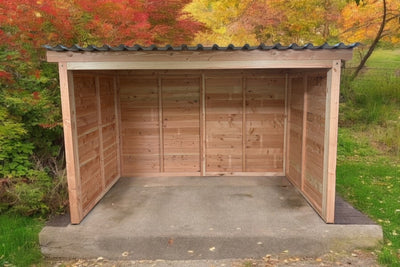Care and maintenance of a wooden shelter: what needs to be considered?

A wooden shelter is a valuable addition to your garden. Whether for storing firewood, garden tools or other utensils - it protects your items from the weather and keeps them tidy. However, regular care and maintenance is essential to ensure that your wooden shelter remains beautiful and functional for a long time. In this article, you will find out what measures you should take to maximize the lifespan of your wooden shelter.
Regular cleaning
The basis of all good maintenance is regular cleaning. Leaves, dirt and organic materials that accumulate on and around the shelter should be removed regularly. These can store moisture and thus promote the development of mold and wood rot.
- Cleaning the roof: Make sure that the roof of the shelter remains free of leaves and branches. This prevents the accumulation of moisture and the associated risk of leaks.
- Clean the walls and floor: Remove dirt and debris from the walls and floor of the shelter. A broom or brush is usually sufficient to remove loose particles.
Protection from moisture
Wood is a natural material that can be quickly damaged by moisture. To prevent rot and mold growth, you should ensure that your shelter is sufficiently protected from moisture.
- Use wood preservative: Regularly apply wood preservatives that are especially suitable for outdoor use. These products protect the wood from moisture, UV radiation and pests.
- Ensure ventilation: Ensure good air circulation in the shelter to allow moisture to escape quickly. This is particularly important if you are storing firewood that needs to dry well to retain its burning properties.
Inspection and repairs

An essential part of maintenance is regularly checking the wood shelter for damage. Minor problems that are detected early can often be rectified with little effort before they lead to major damage.
- Checking for damage: Regularly check the wood for cracks, rot or pest infestation. The roof should also be checked for leaks.
- Quick repairs: Repair minor damage immediately to avoid major problems. Loose boards, damaged roof shingles or leaks should be repaired promptly.
Protection from pests
Wood is susceptible to pests such as woodworms, termites and other insects. To prevent infestation, you should take preventative measures.
- Use insect repellents: If necessary, use special insect repellents to protect the wood from infestation. However, these should be environmentally friendly and suitable for outdoor use.
- Avoid contact with damp ground: Ensure that the shelter does not come into direct contact with damp ground. A firm foundation or a slightly raised structure can help to keep pests away.
Seasonal care
Each season brings its own challenges for your wooden shelter. To be prepared for the changing conditions, you should maintain your shelter seasonally.
- Winter preparation: In the fall, you should winterize the shelter. Remove all organic materials that could freeze in winter and damage the wood. Check the roof for stability and seal any weak points.
- Spring inspection: After the winter, a thorough inspection of the shelter is advisable. Remove any dirt that may have accumulated and check the wood for signs of winter damage such as damp or mold.
Conclusion
A wooden shelter requires regular care and maintenance to maintain its protective function and attractive appearance in the long term. Regular cleaning, protection against moisture and pests and seasonal care will make a significant contribution to the longevity of your shelter. These simple measures will keep your wooden shelter in top condition and provide reliable protection for your garden tools for many years to come.
Are you looking for a durable wooden shelter that is easy to maintain? Visit our Wooden sheltercategory and discover our range of high-quality wooden shelters that are perfectly tailored to your needs!










